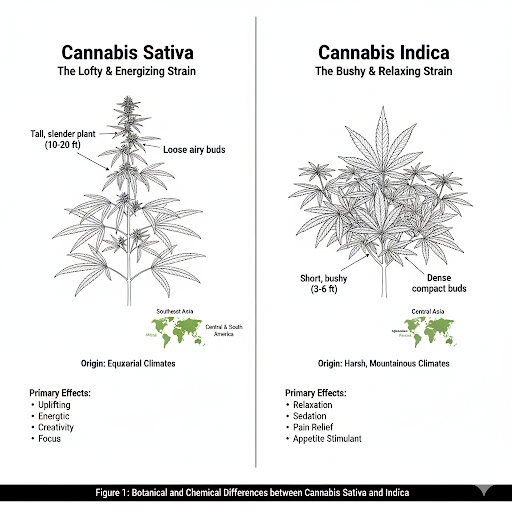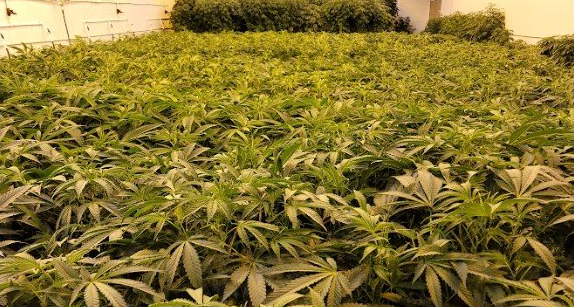The Botanical Divide: Sativa vs. Indica vs. Hybrid Cannabis
The world of cannabis is often categorized by three primary types: Sativa, Indica, and Hybrid. These classifications, while sometimes oversimplified in consumer markets, represent significant botanical and chemical distinctions that influence everything from plant morphology and growth patterns to their perceived effects on the user. Understanding these differences requires a look into their genetic origins, typical chemical compositions, and how they interact with the human endocannabinoid system.
Cannabis Sativa: The Lofty and Energizing Strain
- Geographical Origin: Cannabis Sativa originated in warmer, more equatorial climates, such as Southeast Asia, Central, and South America, and parts of Africa.
- Plant Morphology: Sativa plants are characterized by their tall, slender stature, often reaching heights of 10-20 feet in outdoor cultivation. They have loose, airy branching with narrow, long leaves. The flowers (buds) tend to be less dense and more elongated.
- Growth Cycle: Sativa plants have a longer flowering period compared to Indica strains.
Common Effects: Sativa strains are often associated with an "uplifting" and "cerebral" high. Users frequently report feelings of energy, creativity, focus, and euphoria. These effects are often attributed to a typically higher THC:CBD ratio and a terpene profile rich in compounds like limonene and pinene, which are known for their stimulating properties.

Cannabis Indica: The Bushy and Relaxing Strain
- Geographical Origin: Cannabis Indica originated in harsh, mountainous regions of Central Asia, such as Afghanistan, Pakistan, and India.
- Plant Morphology: Indica plants are typically shorter and bushier than Sativas, usually growing between 3-6 feet tall. They have dense, compact branching with broad, dark green leaves. The flowers are usually denser and more clustered.
- Growth Cycle: Indica plants generally have a shorter flowering period and are more resilient to colder climates.
Common Effects: Indica strains are often associated with a "body high" and profound relaxation. Users commonly report feelings of sedation, pain relief, muscle relaxation, and increased appetite. These effects are often linked to a terpene profile rich in myrcene, which is known for its sedative qualities, and sometimes a more balanced THC:CBD ratio, though many powerful Indica strains are high in THC.
Hybrid Strains: The Best of Both Worlds
Hybrid strains are the result of cross-breeding Sativa and Indica plants, aiming to combine desirable traits from both. Most cannabis available today is, in fact, a hybrid, with varying degrees of Sativa or Indica dominance.
- Plant Morphology: Hybrid plants exhibit a range of characteristics depending on their genetic lineage. They can be tall like Sativas or bushy like Indicas, or a combination of both.
- Common Effects: The effects of hybrids are as diverse as their genetics. A Sativa-dominant hybrid might offer an uplifting experience with some physical relaxation, while an Indica-dominant hybrid could provide deep relaxation with a touch of mental clarity. The specific cannabinoid and terpene profiles dictate the overall experience.
The California Cannabis Market: Purchasing and Search Trends
California, a pioneering state in cannabis legalization, offers a mature and data-rich market for observing consumer trends.
- Purchasing Trends: While both Sativa and Indica strains have dedicated consumers, hybrid strains tend to be the most purchased category in California dispensaries. This preference is driven by consumers seeking specific combinations of effects, often desiring a balanced experience that avoids the extremes of pure Sativa's potential anxiety or pure Indica's profound sedation. Many consumers also gravitate towards hybrids to find relief for a wider range of ailments without sacrificing functionality. Anecdotal evidence from budtenders further supports the demand for nuanced effects offered by hybrids.
- Google Search Trends: Analysis of Google search data within California often reveals interesting insights. While all three terms (Sativa, Indica, Hybrid) are searched frequently, "Indica" and "Sativa" typically generate more unique searches than "Hybrid." This seemingly contradictory trend can be explained by a few factors:
- Educational Inquiry: Consumers new to cannabis or those seeking to understand basic distinctions often start by researching the fundamental differences between Sativa and Indica.
- Specific Effect Seeking: Individuals looking for very specific effects (e.g., strong sedation for sleep or intense energy for daytime use) are more likely to search for "Indica" or "Sativa" to narrow down their options.
- Strain Name Searches: While "Hybrid" is a category, consumers are more likely to search for specific hybrid strain names (e.g., "Blue Dream," "Girl Scout Cookies") rather than the generic term "Hybrid."
In conclusion, while Sativa and Indica represent distinct botanical lineages with characteristic effects, the modern cannabis market, particularly in places like California, is dominated by hybrid strains. These hybrids cater to a sophisticated consumer base that prioritizes tailored experiences, reflecting a growing understanding of the complex interplay of cannabinoids and terpenes that truly define the cannabis experience.




